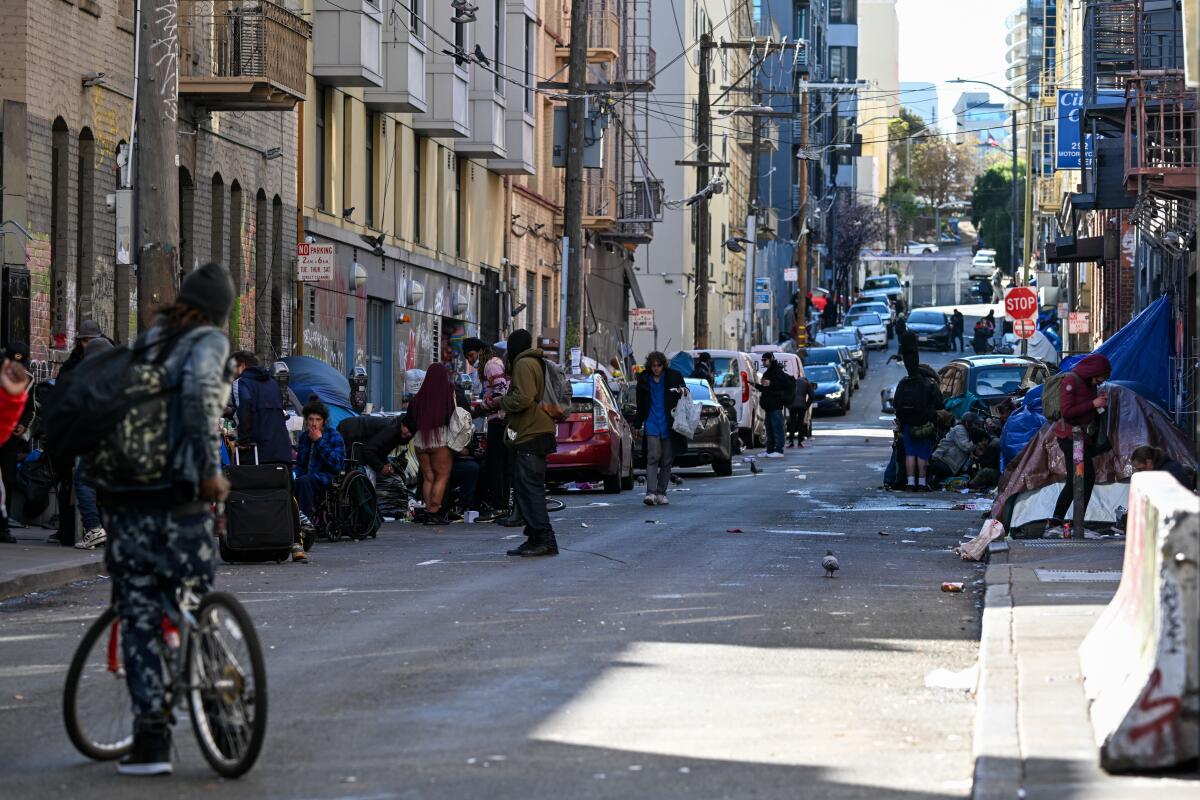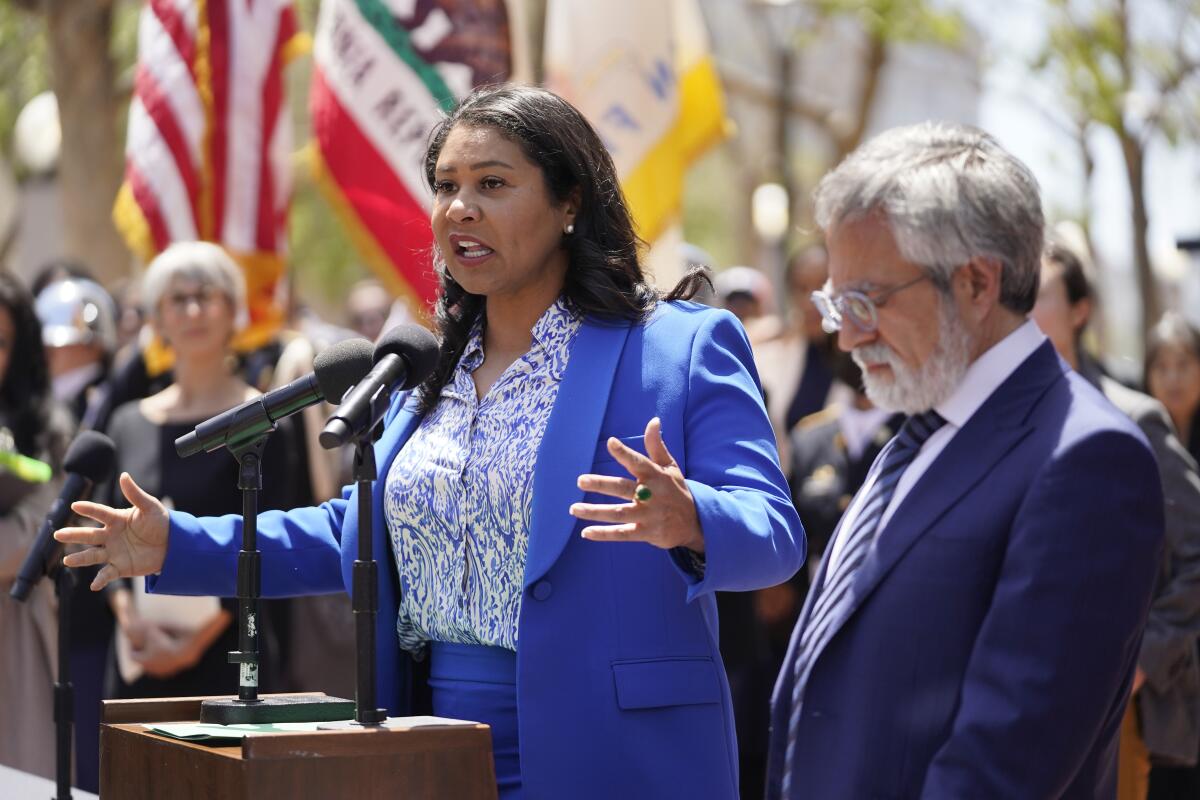
A week into what Mayor London Breed called a “very aggressive” effort to eliminate homeless encampments across San Francisco, a key question looms: Where will the people living in those tents go?
Outreach workers, backed by law enforcement officers, have deployed in recent days in targeted efforts to clear some of San Francisco’s most visible encampments, confiscating personal belongings and telling owners it’s time to pack up and leave.
They have been clearing unauthorized tent camps under freeways and on a stretch of sidewalk in the drug-infested Tenderloin neighborhood in an effort to force people off the streets. On Monday, city workers visited a longtime encampment lining the sidewalks outside San Francisco’s only DMV office, which had been cleared more than a dozen times this year only to be resurrected a few days later.
On Monday evening, the sidewalks were clean.
Breed’s efforts are bolstered by a landmark June 28 U.S. Supreme Court decision that allowed local communities to more severely restrict homeless encampments on sidewalks and other public property.
In response, Breed said San Francisco, a city that has become a favorite scapegoat for the far right because of its homelessness crisis, would launch a more aggressive effort to eliminate encampments. The time has come, she said, to address the problem “differently than we have done so far.”

Despite years of efforts to move people into shelters or housing, street encampments remain a visible problem in San Francisco.
(Tayfun Coskun/Getty Images)
An estimated 8,300 people are homeless in San Francisco, about half of whom sleep in parks or on sidewalks in makeshift shelters. Despite years of efforts to relocate people to temporary or permanent shelters, tent encampments remain a glaring problem, often accompanied by trash, theft and open drug use.
For years, Breed and other city officials have said they were bound by rulings from the U.S. Court of Appeals for the 9th Circuit, which held that it was cruel and unusual punishment to penalize someone for sleeping rough when no legal shelter was available. Now, bolstered by the Supreme Court’s decision, city officials can take a tougher stance if people refuse help.
But San Francisco, like many other West Coast cities seeking to combat encampments, has yet to determine where people are supposed to go once their tents are dismantled: The city’s shelters — with about 3,600 beds — are at 94% capacity, according to the San Francisco Department of Homelessness and Assisted Housing.
“Unfortunately, San Francisco does not have enough shelters or housing for every person experiencing homelessness, but we have a few beds available each day to support the work of outreach teams, and we continue to expand our system,” department spokeswoman Emily Cohen wrote in an email.
Jeff Cretan, a spokesman for the mayor, said the city wasn’t necessarily expecting a massive influx of new people into shelters. After years of trying to relocate people indoors, those still living on the streets tend to be the most reluctant to accept offers of shelter, often because they suffer from mental illness and substance abuse.
During the first three days of sweeping encampments this week, only about 10 percent of people offered shelter accepted it, Cretan said.
Instead, Breed, who is in the midst of a tough re-election campaign, is looking to strategies other than expanding shelter beds. She said the city could impose criminal penalties on people who repeatedly refuse shelter. But the prospect of local jails handling hundreds more homeless people also raises capacity concerns.
On Thursday, Breed emphasized a different approach. She issued an executive directive requiring outreach workers to provide homeless people who are not from San Francisco with free transportation out of the city — to cities where they have family, friends or other connections. Cretan said the city would cover the cost of bus, plane or train tickets.
The city has had a similar program for years, but it has lost traction during the pandemic. Under the new directive, workers must insist on the relocation option before offering any other city services, including housing and shelter.
According to the city’s 2024 annual homeless survey, about 40% of people living on the streets said they were not from San Francisco.
“This directive will ensure that relocation services are the first response to our homelessness and addiction crises, allowing individuals to choose to reconnect with support networks before accessing other city services or facing the consequences of being denied care,” Breed wrote in the directive.

San Francisco Mayor London Breed faces a tough re-election bid with homelessness a hot-button issue. Board of Supervisors Chairman Aaron Peskin, right, is among her opponents.
(Eric Risberg / Associated Press)
Breed’s hardline approach has drawn sharp criticism from homeless advocates, who argue that clearing out tents does not address the poverty and drug addiction that drive homelessness — and who say his efforts are politically motivated.
“Policies to address homelessness must be humane, lawful and effective, not implemented simply because someone’s job is at stake,” said Aaron Peskin, chairman of the San Francisco Board of Supervisors and one of Breed’s opponents for mayor.
Peskin instead called for stronger rent control and eviction protections, and for the city to expand shelter and affordable housing options.
Since Breed took office, the city has increased shelter capacity from 2,500 beds to nearly 4,000, the mayor’s office said, and the number of permanent assisted-living units to about 14,000. Cohen, of the Department of Homelessness and Assisted Housing, cited those efforts as the reason the number of people living on the city’s streets is at “the lowest level in at least 10 years.”
Cretan said the relocation offers and the threat of criminal penalties are just a starting point while the city figures out what strategies will work.
“The mayor really wants to clarify [that] “You have to be willing to take cover. But obviously not everyone is going to say yes,” Cretan said. “It’s not like you snap your fingers and everything changes overnight.”


